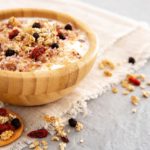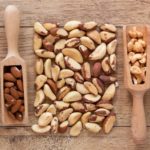
Farha Ramzan
Research Fellow
With so many different foods on the shelves of the supermarket, we sometimes forget that nuts make a great addition to everyday meals.
Apart from a good taste, and being quite filling, research and studies show different anti-cancer effects in both animal and human studies.
Today we will talk about the anti-cancer effects of
- almonds
- Brazil nuts
- cashews
- chestnuts
- hazelnuts
- macadamia nuts
- peanuts
- pecans
- pine nuts
- pistachios
- walnuts
If you are just joining us in this series, we suggest first checking the previous article Anti-cancer foods: The Healthiest Nuts (Part 1).
Almonds
Almond (Prunus dulcis Miller D. A. Webb), a nut that belongs to the Rosaceae family, is well known to be a source of essential nutrients.
Almonds are rich in protein, dietary fibres, unsaturated fatty acids, and micronutrients
- vitamin E
- niacin
- magnesium
- riboflavin
RELATED — Vitamin B2 (Riboflavin)
Also, almond skin is reported to be a source of non-nutrient bioactives, such as polyphenolic compounds.
Both nutrient and non-nutrient bioactives in almonds are shown to play a role in the mechanism of reducing the risk of cardiovascular diseases.[1]
Almonds also contain significant amounts of l-arginine, the biological precursor of nitric oxide (potent vasodilator) and are also natural source of phytosterols, that contribute to their LDL cholesterol–lowering properties.
In a recent dietary intervention trial (Almonds Trial Targeting Dietary Intervention with Snacks, or ATTIS), it was observed that intake of whole almonds led to improvement in
- endothelial function
- cardiac autonomic function
- LDL cholesterol (lower values)
Also, in another study, a daily consumption of 40 grams of almonds substituted for a high‐carbohydrate snack was shown to reduce the key risk factors for cardiometabolic dysfunction (non‐HDL‐cholesterol, LDL cholesterol, and central adiposity), while maintaining the levels of HDL cholesterol.
Additionally, in a study focused on colon cancer in rats, the authors suggest that almond consumption for 26 weeks has a positive impact on reducing the risk of developing colon cancer when fed an almond-rich diet compared to control.[2]
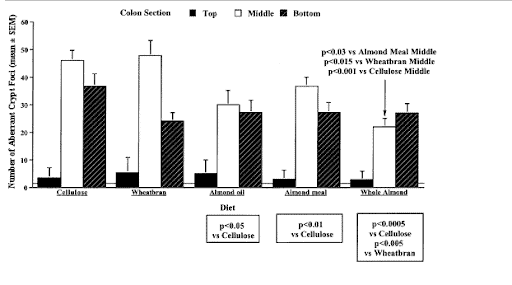
However, these observations are only in animal or cell-models without any strong human dietary intervention evidence.
Brazil nuts
Brazil nuts (Bertholletia excelsa) are South American tree nuts, belonging to the family Lecythidaceae.
Brazilian nuts are characterized by a high content of several bioactive compounds, including
- phenolic compounds
- mono and polyunsaturated fatty acids
- tocopherol
- folate
- magnesium
- potassium
- proteins
- calcium[4]
Brazil nuts are a major food source of selenium
Selenium is an essential micronutrient that is necessary for the functioning of glutathione peroxidase (GPx), an antioxidant enzyme that protects membrane lipids and other cellular and extracellular components from oxidative damage.
Additionally, due to the high concentration of unsaturated fatty acids in Brazil nuts, they are reported to improve
- lipid peroxidation
- lipid profile
- microvasculature
in individuals with obesity.
Selenium present in brazil nuts is reported to have anticarcinogenic effects.[5]
A study was conducted in 32 healthy volunteers over 50 years of age with low plasma levels of selenium. They were instructed to take one of the following
- Brazil nuts
- green tea extract capsules
- combination of Brazil nuts and green tea extract capsules
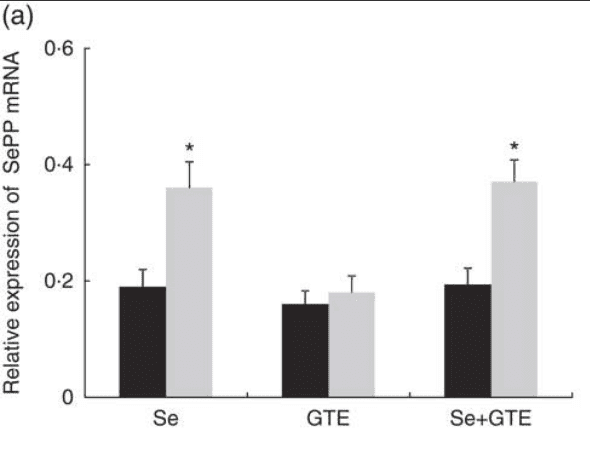
Black column (before). Gray column (after).
The study showed that all three options regulated biomarkers related to risk of colorectal cancer in these participants, providing protective effects.[6]
Cashew
Cashew (Anacardium occidentale L.) is a soft and slightly sweet, flavoured nut, belonging to family Anacardiaceae.
Cashews are reported to have a high lipid content (47.8 g/100g) and are a great source of unsaturated fatty acids—oleic (ω-9) and linoleic (ω-6) acid.
The most important micronutrients found in cashews are tocopherol (α‐tocopherol and γ‐tocopherol) and folate. Other bioactive compounds present in cashews include
- β‐carotene
- lutein
- zeaxanthin
- thiamine
RELATED — Vitamin B1 (Thiamine)
Cashew nuts are known to have antiproliferative and cytotoxic activities, these properties are attributed due to the presence of flavonoids and polyphenols in these nuts.[7]
For example, methanolic extract of cashew nuts are shown to exert cytotoxic activity against liver (HepG2) and breast (MCF7) cancer cells through cell cycle stopping.[7,8]
Intake of cashews are shown to prevent the development of metabolic disorders and protect against cardiovascular diseases.
Daily intake of cashew nuts in mouse models of colitis was shown to reduce
- histological damage
- macroscopic damage
- neutrophil infiltration
- pro-inflammatory cytokines[9]
In another study involving 50 patients with type 2 diabetes, daily consumption of cashews for eight weeks was reported to reduce HOMA-IR (homeostatic model assessment of insulin resistance) and LDL cholesterol and HDL cholesterol ratio.[10]
RELATED — Diabetes: Early Signs, Causes, Types and Treatment
Although these studies have established the anti-inflammatory and antioxidant role of cashew nut intake, further long-term studies with larger sample sizes are needed to confirm the beneficial effects of cashew intake on cancer.
Chestnut
Chestnut (Castanea Sativa Mill) belongs to the Fagaceae family.
Chestnuts are reported to be low-fat fruits containing high amounts of fibre, starch, minerals (such as calcium, magnesium, iron, copper, zinc, phosphorus, potassium) and vitamins, especially vitamin C.
RELATED — Vitamin C (Immunity and Collagen booster)
Chestnuts contain phospholipids, tocopherols, sterols and fatty acids, particularly polyunsaturated fatty acids including linoleic and oleic acid.[11]
Chestnuts are also low in sodium and high in potassium, phosphorus and magnesium.
RELATED — Magnesium (for a great night of sleep)
Being rich in antioxidants and phytochemicals, studies have shown positive health benefits of chestnut extracts such as gallic, ellagic, and syringic acids.
Studies done in animal and cell models have confirmed that chestnuts have the following properties
- antioxidant
- anti-inflammatory
- anticancer
- hypocholesterolemic
- neuroprotective
Among the anti-cancer activity, chestnut extract or powder is shown to have cytotoxic effects on the liver and gastric cell lines.[12]
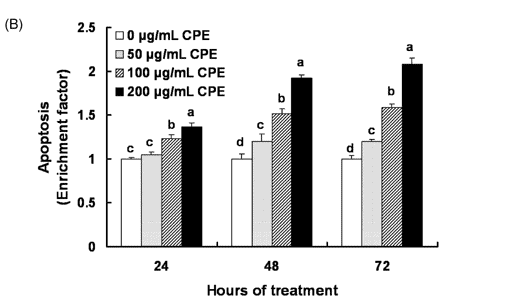
Hazelnut
Hazelnut (Corylus avellana L.) belongs to the Betulaceae family, and it is one of the most popular nuts consumed worldwide.
Hazelnuts are a rich source of antioxidants
A portion of 30g of hazelnuts daily provides us with 10% of daily amount of dietary fibre.
Hazelnuts are also rich in diverse types of polyphenols such as flavan-3-ols, and through their antioxidant, anti-inflammatory and hypolipidemic effects have been linked to protection against several chronic diseases.[15]
Due to their unique composition of phenolic compounds, the consumption of hazelnuts may contribute to the prevention of colon cancer.[16]
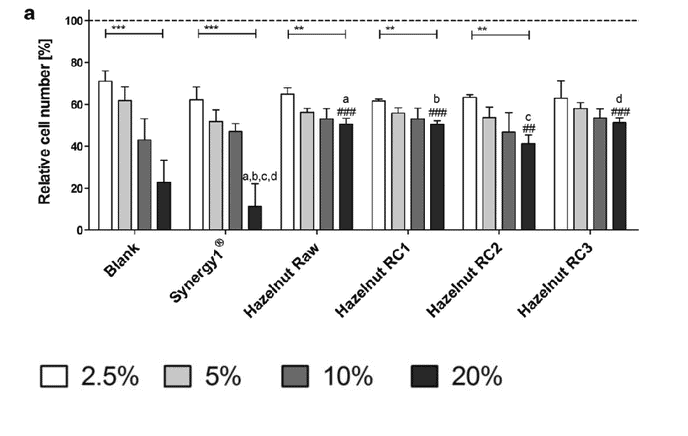
RC1 = 140.6°C/25 min, RC2 = 155.1°C/20 min, RC3 = 180.4°C/21 min
For example, roasted and raw hazelnut extracts are shown to exhibit chemo-preventive effects in colon adenoma cells.[17]
Macadamia nut
Macadamia nuts (Macadamia tetraphylla) belong to the family Proteaceae. They have a subtle, butter‐like flavor, with a creamy texture.
Macadamias are predominantly composed of lipids, accounting for about three‐quarters of the kernel weight, with triglycerides accounting for more than 95% of the lipid constituents.
Due to high content of dietary fibre, macadamia nuts are reported to show cytotoxic activity and are shown to reduce the risk of colon cancer development.[18]
In a study done in colon adenoma cells, raw and roasted macadamia nuts were shown to decrease the growth of these cells, suggesting chemopreventive effects of these nuts.
Macadamia nuts have cardioprotective effects
Inclusion of 1.5 ounces (42.5g/daily) of macadamia nuts in a cholesterol-lowering diet is shown to significantly reduce total and LDL cholesterol concentrations in the blood of hypercholesterolemic men and women.[19,20]
It is presumed that these effects are due to the high concentration of monounsaturated fatty acids in these nuts (56.5% of energy from oleic acid and 13.9% of energy from palmitoleic acid).
Macadamia nuts are mostly eaten roasted, with roasting increasing the concentration of their bioactive components.
However, excessive roasting could lead to increased lipid oxidation resulting in rancidity and deterioration of these nuts, making them both unhealthy and undesirable to consume.
Peanut
Peanut (Arachis hypogaea) is not considered a true nut, but it contains bioactive compounds with similar nutrient composition and health benefits as true nuts.
Among these bioactives, peanuts are a rich source of
- stilbenes
- flavonoids
- phenolic acids
- phytosterols
Peanut bioactive components are reported to exert their effects as
- antioxidants
- activators of liver detoxification enzymes
- inhibiting or lowering of cholesterol absorption
In particular, peanuts are a dietary food source of resveratrol, with potent antioxidant properties implicated in reducing the risk of cancer, cardiovascular diseases, and age-related neurological disease.[21]
Several studies have shown that peanut consumption helps to moderate glucose concentrations, improve the postprandial lipid response, and maintain vascular function.[22]
Studies on cancer have shown the anticarcinogenic effects of peanut consumption.
For example , a case-control study involving 222 individuals, protective effects of peanut consumption was reported against the risk of developing esophageal squamous cell carcinoma (ESCC).[23]
However, there are some controversial studies showing that frequent consumption of peanuts by cancer patients may increase risk of metastasis in these patients.[24]
If you are currently undergoing cancer treatment, we suggest you check with your doctor if you should be consuming peanuts, just to be on the safe side.
Pecan
Pecan nuts (Carya illinoinensis) are tree nuts with reported antioxidant and antimicrobial activities.
Total flavonoid content is at 34 mg/100 g concentration, and predominantly consists of flavan-3-ols and anthocyanins.
Pecans have the highest flavonoid content among all nuts
Various phenolic compounds such as
- gallic acid
- 4-hydroxybenzoic acid
- chlorogenic acid
- vanillic acid
- caffeic acid
- ellagic acid
- catechin
- epicatechin
- epigallocatechin
- epicatechin gallate
present in the shells of these nuts have been associated with multiple biological effects, including antitumour activities.[25]
For instance, a study done in human breast cancer cell lines and mice breast cancer models, showed that increased concentration of pecan nut shell extract resulted in induction of cancer cell death by apoptosis.[26]
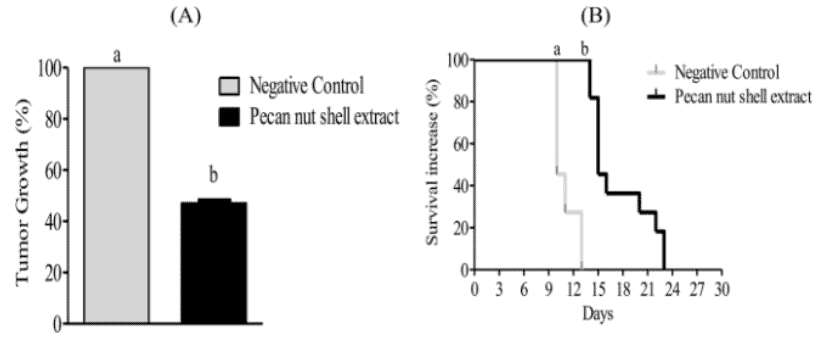
Pine nut
Pine nuts (Araucaria angustifolia) are recognized for their high nutritional value and to have a positive impact on the health due to the presence of various phytocystatins.
Pine nuts contain several classes of bioactive compounds including
- resveratrol
- selenium
- flavonoids (quercetin)
- polyphenols (ellagic acid)
- folic acid
which may prevent cancer through antioxidants, regulation of cell differentiation and proliferation, and reduction of DNA damage.[27]
For example, pinolenic acid, a fatty acid found in pine nut oil, has shown to affect cancer metastasis by inhibiting the invasiveness and motility of human breast cancer (MDA-MB-231) cells.[28]
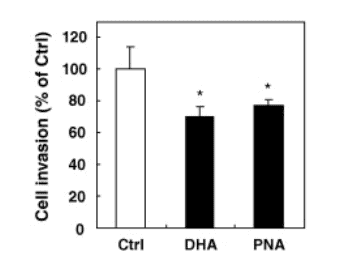
Also, resveratrol present in pine nuts is known to regulate inflammatory responses.
Pistachios
Pistachio nut (Pistacia vera L.) belongs to the family of Anacardiaceae.
Compared to other tree nuts, pistachios have a lower fat and energy content, and contain the highest levels of
- unsaturated fatty acids
- potassium
- tocopherol
- phytosterols
- xanthophyll carotenoids
- vitamins (especially vitamin B6)
Pistachio is also high in fibre content as compared to other nuts, with 10% of its insoluble weight being fibre.
In addition, consumption of pistachio is also shown to affect the glycaemic response and endothelial function in the body.[29]
In a recent systematic review and meta-analysis of randomized controlled trials, it was reported that consuming pistachio nuts may improve
- lipid profiles of total cholesterol (TC)
- low-density lipoprotein-cholesterol (LDL-C)
- high-density lipoprotein-cholesterol (HDL-C)
- triglyceride (TG)
This suggests protective action against cardiometabolic diseases.[30]
Pistachios are reported to possess chemopreventive potential due to butyrates and selenium, both shown to inhibit growth in colon cancer cell models.[31]
For example, pistachios are shown to reduce the number and growth of LT97 colon adenoma cells.
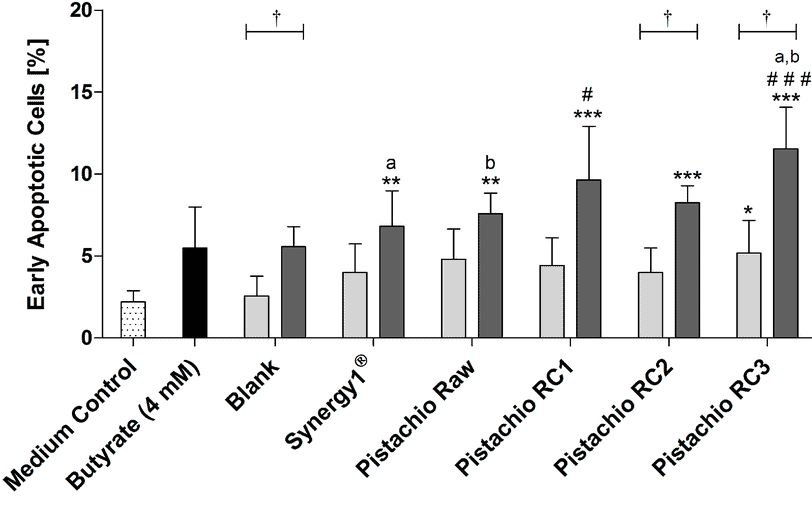
RC1 = 141 °C/25 min, RC2 = 160 °C/15 min, RC3 = 185 °C/21 min
Additionally, pistachios are reported to present a low glycaemic index, contributing to reduced postmeal glucose increase and maintaining satiety longer.
Both of these are important in preventing chronic health conditions, including type 2 diabetes, obesity and cardiovascular diseases.
Walnuts
Walnuts (Juglans regia) are highly nutritious nuts contributing prominently to the Mediterranean diet.
Walnuts are shown to exhibit antiproliferative, anticancer and antioxidative properties.
Walnuts boost brain function
Walnuts are also shown to significantly reduce the low-density lipoprotein-cholesterol (LDL-C) concentration when compared with the control diet in human studies.
Studies have identified several cancer-preventing biochemicals, including
- n-3 (omega-3) fatty acids
- tocopherols
- penta-O-galloyl-β-d-glucose
- quercetin 3-β-d-glucoside β-sitosterol
- pedunculagin
- melatonin
For example, walnut consumption in women with breast cancer is shown to suppress growth and survival of breast cancer lumps.[32]
Consumption of walnuts is also shown to reduce the risk of colorectal cancer by altering the gut microbiota.[33]
In a study involving mouse tumour models, the effects of walnuts on gut microbiota were tested, by adding them to the total Western diet (TWD).
From the 3 types of tumours in the study, walnut consumption was associated with reducing 1 type of tumour.
Summary
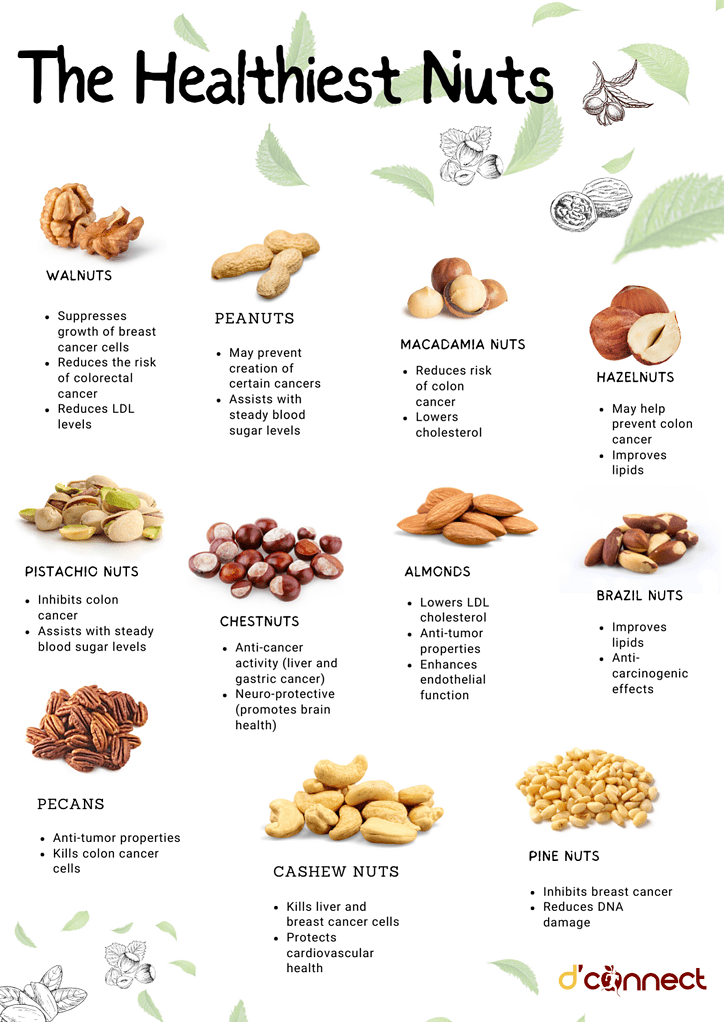
We included some of the most important properties for each type of nut. Feel free to download and share the illustration with your friends and family.
Related Questions
1. How many walnuts should I eat a day?
The recommended daily requirement for any nut is 30g per day. Accordingly, you can have at least 6-7 walnuts a day.
A good suggestion is to mix different nuts for wholesome benefits.
2. Should I soak almonds before eating them?
There are claims that soaked almonds have better digestibility and enhanced absorption.
However, there is limited scientific evidence to prove this.
3. Is macadamia nut oil good for cooking at high temperatures?
Macadamia nut oil is one of the high smoke point oils, which means that it is good for cooking at high temperatures.
4. Are pine nuts high in histamine?
Pine nuts are low in histamine but they can trigger the release of endogenous histamines.
5. Are chestnuts high in sugar?
Chestnuts are nutritionally rich nuts with high content of sugar (20–32%) and starch (50–60%).
If you have just joined us in this series on anti-cancer foods, we suggest reading the 3-part article on cancer fighting herbs, starting with Anti-cancer foods: The Healthiest Herbs and Spices (Part 1).
Farha is a Researcher at Liggins Institute, the University of Auckland. Her research interests involve understanding the complex interplay between the genetics, epigenetics and dietary patterns of an individual and how these interactions predispose an individual to develop metabolic diseases.
Currently, Dr Ramzan is working on projects aimed at establishing New Zealand based plants as functional foods.
References
(1) Berryman, C. E., West, S. G., Fleming, J. A., Bordi, P. L., & Kris-Etherton, P. M. (2015). Effects of daily almond consumption on cardiometabolic risk and abdominal adiposity in healthy adults with elevated LDL-cholesterol: A randomized controlled trial. Journal of the American Heart Association, 4(1). https://doi.org/10.1161/JAHA.114.000993
(2) Davis, P. A., & Iwahashi, C. K. (2001). Whole almonds and almond fractions reduce aberrant crypt foci in a rat model of colon carcinogenesis. Cancer Letters, 165(1), 27–33. https://doi.org/10.1016/S0304-3835(01)00425-6
(3) Shi, J., Chen, Q., Xu, M., Xia, Q., Zheng, T., Teng, J., … Fan, L. (2019). Recent updates and future perspectives about amygdalin as a potential anticancer agent: A review. Cancer Medicine. Wiley-Blackwell. https://doi.org/10.1002/cam4.2197
(4) Alcântara, D. B., Dionísio, A. P., Artur, A. G., Silveira, B. K. S., Lopes, A. F., Guedes, J. A. C., … Zocolo, G. J. (2022). Selenium in Brazil nuts: An overview of agronomical aspects, recent trends in analytical chemistry, and health outcomes. Food Chemistry. Elsevier. https://doi.org/10.1016/j.foodchem.2021.131207
(5) Ip, C., & Lisk, D. J. (1994). Bioactivity of selenium from Brazil nut for cancer prevention and selenoenzyme maintenance. Nutrition and cancer, 21(3), 203–212. https://doi.org/10.1080/01635589409514319
(6) Hu, Y., McIntosh, G. H., Le Leu, R. K., Somashekar, R., Meng, X. Q., Gopalsamy, G., … Young, G. P. (2016). Supplementation with Brazil nuts and green tea extract regulates targeted biomarkers related to colorectal cancer risk in humans. The British journal of nutrition, 116(11), 1901–1911. https://doi.org/10.1017/S0007114516003937
(7) Hikal, D. M., Awad, N. S., & Abdein, M. A. (2017). The anticancer activity of cashew (Anacardium occidentale) and almond (Prunus dulcis) kernels. Advances in Environmental Biology (Vol. 11). American-Eurasian Network for Scientific Information.
(8) Konan, N. A., Lincopan, N., Collantes Díaz, I. E., de Fátima Jacysyn, J., Tanae Tiba, M. M., Pessini Amarante Mendes, J. G., … Spira, B. (2012). Cytotoxicity of cashew flavonoids towards malignant cell lines. Experimental and Toxicologic Pathology, 64(5), 435–440. https://doi.org/10.1016/j.etp.2010.10.010
(9) Siracusa, R., Fusco, R., Peritore, A. F., Cordaro, M., D’amico, R., Genovese, T., … Impellizzeri, D. (2020). The Antioxidant and Anti-Inflammatory Properties of Anacardium occidentale L. Cashew Nuts in a Mouse Model of Colitis. Nutrients, 12(3). https://doi.org/10.3390/NU12030834
(10) Damavandi, R. D., Mousavi, S. N., Shidfar, F., Mohammadi, V., Rajab, A., Hosseini, S., & Heshmati, J. (2019). Effects of Daily Consumption of Cashews on Oxidative Stress and Atherogenic Indices in Patients with Type 2 Diabetes: A Randomized, Controlled-Feeding Trial. International Journal of Endocrinology and Metabolism, 17(1), 70744. https://doi.org/10.5812/IJEM.70744
(11) Rodrigues, P., Ferreira, T., Nascimento-Gonçalves, E., Seixas, F., da Costa, R. M. G., Martins, T., … Oliveira, P. A. (2020). Dietary supplementation with chestnut (Castanea sativa) reduces abdominal adiposity in FVB/n mice: A preliminary study. Biomedicines, 8(4), 75. https://doi.org/10.3390/biomedicines8040075
(12) Cacciola, N. A., Squillaci, G., D’Apolito, M., Petillo, O., Veraldi, F., Cara, F. La, … Morana, A. (2019). Castanea sativa Mill. Shells Aqueous Extract Exhibits Anticancer Properties Inducing Cytotoxic and Pro-Apoptotic Effects, 24(18). https://doi.org/10.3390/MOLECULES24183401
(13) Lee, H. S., Kim, E. J., & Kim, S. H. (2011). Chestnut extract induces apoptosis in AGS human gastric cancer cells. Nutrition Research and Practice, 5(3), 185. https://doi.org/10.4162/NRP.2011.5.3.185
(14) Sorice, A., Siano, F., Capone, F., Guerriero, E., Picariello, G., Budillon, A., … Volpe, M. G. (2016). Potential anticancer effects of polyphenols from chestnut shell extracts: Modulation of cell growth, and cytokinomic and metabolomic profiles. Molecules, 21(10). https://doi.org/10.3390/molecules21101411
(15) Brown, R., Ware, L., & Tey, S. L. (2022). Effects of Hazelnut Consumption on Cardiometabolic Risk Factors and Acceptance: A Systematic Review. International Journal of Environmental Research and Public Health. MDPI. https://doi.org/10.3390/ijerph19052880
(16) Caimari, A., Puiggròs, F., Suárez, M., Crescenti, A., Laos, S., Ruiz, J. A., … Arola, L. (2015). The intake of a hazelnut skin extract improves the plasma lipid profile and reduces the lithocholic/deoxycholic bile acid faecal ratio, a risk factor for colon cancer, in hamsters fed a high-fat diet. Food Chemistry, 167, 138–144. https://doi.org/10.1016/j.foodchem.2014.06.072
(17) Glei, M., Fischer, S., Lamberty, J., Ludwig, D., Lorkowski, S., & Schlörmann, W. (2018). Chemopreventive potential of in vitro fermented raw and roasted hazelnuts in LT97 colon adenoma cells. Anticancer Research, 38(1), 83–93. https://doi.org/10.21873/anticanres.12195
(18) Schlörmann, W., Dinc, T., Lorkowski, S., & Glei, M. (2017). Influence of roasting on the chemopreventive potential of macadamia nuts. SDRP Journal of Food Science & Technology, 2(1). https://doi.org/10.25177/jfst.2.1.5
(19) Tu, X. H., Wu, B. fu, Xie, Y., Xu, S. L., Wu, Z. Y., Lv, X., … Chen, H. (2021). A comprehensive study of raw and roasted macadamia nuts: Lipid profile, physicochemical, nutritional, and sensory properties. Food Science & Nutrition, 9(3), 1688. https://doi.org/10.1002/FSN3.2143
(20) Griel, A. E., Cao, Y., Bagshaw, D. D., Cifelli, A. M., Holub, B., & Kris-Etherton, P. M. (2008). A Macadamia Nut-Rich Diet Reduces Total and LDL-Cholesterol in Mildly Hypercholesterolemic Men and Women. The Journal of Nutrition, 138(4), 761–767. https://doi.org/10.1093/JN/138.4.761
(21) Sales, J. M., & Resurreccion, A. V. A. (2014). Resveratrol in Peanuts. Critical Reviews in Food Science and Nutrition, 54(6), 734–770. https://doi.org/10.1080/10408398.2011.606928
(22) Liu, X., Hill, A. M., West, S. G., Gabauer, R. M., McCrea, C. E., Fleming, J. A., & Kris-Etherton, P. M. (2017). Acute peanut consumption alters postprandial lipids and vascular responses in healthy overweight or obese men. Journal of Nutrition, 147(5), 835–840. https://doi.org/10.3945/jn.116.246785
(23) Zhao, Y., Zhao, L., Hu, Z., Wu, J., Li, J., Qu, C., … Song, Q. (2018). Peanut consumption associated with a reduced risk of esophageal squamous cell carcinoma: A case–control study in a high-risk area in China. Thoracic Cancer, 9(1), 30–36. https://doi.org/10.1111/1759-7714.12520
(24) Frequent consumption of peanuts by cancer patients may increase risk of cancer spread, study finds – ScienceDaily. (n.d.). Retrieved March 7, 2023, from https://www.sciencedaily.com/releases/2021/08/210804123555.htm
(25) Ribas, L. E., Baravalle, M. E., Gasser, F. B., Renna, M. S., Addona, S., Ortega, H. H., … Hein, G. J. (2021). Extraction of phenolic compounds from the shells of pecan nuts with cytotoxic activity through apoptosis against the colon cancer cell line HT-29. Journal of Food Science, 86(12), 5409–5423. https://doi.org/10.1111/1750-3841.15950
(26) Hilbig, J., Policarpi, P. de B., Grinevicius, V. M. A. de S., Mota, N. S. R. S., Toaldo, I. M., Luiz, M. T. B., … Block, J. M. (2018). Aqueous extract from pecan nut [Carya illinoinensis (Wangenh) C. Koch] shell show activity against breast cancer cell line MCF-7 and Ehrlich ascites tumor in Balb-C mice, 211, 256–266. https://doi.org/10.1016/J.JEP.2017.08.012
(27) Takala, R., Ramji, D. P., & Choy, E. (2023). The Beneficial Effects of Pine Nuts and Its Major Fatty Acid, Pinolenic Acid, on Inflammation and Metabolic Perturbations in Inflammatory Disorders. International Journal of Molecular Sciences 2023, Vol. 24, Page 1171, 24(2), 1171. https://doi.org/10.3390/IJMS24021171
(28) Chen, S. J., Hsu, C. P., Li, C. W., Lu, J. H., & Chuang, L. Te. (2011). Pinolenic acid inhibits human breast cancer MDA-MB-231 cell metastasis in vitro. Food chemistry, 126(4), 1708–1715. https://doi.org/10.1016/J.FOODCHEM.2010.12.064
(29) Kendall, C. W. C., West, S. G., Augustin, L. S., Esfahani, A., Vidgen, E., Bashyam, B., … Jenkins, D. J. (2014). Acute effects of pistachio consumption on glucose and insulin, satiety hormones and endothelial function in the metabolic syndrome. European journal of clinical nutrition, 68(3), 370–375. https://doi.org/10.1038/EJCN.2013.275
(30) Parham, M., Heidari, S., Khorramirad, A., Hozoori, M., Hosseinzadeh, F., Bakhtyari, L., & Vafaeimanesh, J. (2014). Effects of pistachio nut supplementation on blood glucose in patients with type 2 diabetes: a randomized crossover trial. The review of diabetic studies : RDS, 11(2), 190–196.
(31) Glei, M., Ludwig, D., Lamberty, J., Fischer, S., Lorkowski, S., & Schlörmann, W. (2017). Chemopreventive Potential of Raw and Roasted Pistachios Regarding Colon Carcinogenesis. Nutrients, 9(12). https://doi.org/10.3390/NU9121368
(32) Hardman, W. E., Primerano, D. A., Legenza, M. T., Morgan, J., Fan, J., & Denvir, J. (2019). Dietary walnut altered gene expressions related to tumor growth, survival, and metastasis in breast cancer patients: a pilot clinical trial. Nutrition research (New York, N.Y.), 66, 82–94. https://doi.org/10.1016/J.NUTRES.2019.03.004
(33) Chen, Y., Nakanishi, M., Bautista, E. J., Qendro, V., Sodergren, E., Rosenberg, D. W., & Weinstock, G. M. (2020). Colon Cancer Prevention with Walnuts: A Longitudinal Study in Mice from the Perspective of a Gut Enterotype-like Cluster. Cancer prevention research (Philadelphia, Pa.), 13(1), 15–24. https://doi.org/10.1158/1940-6207.CAPR-19-0273


